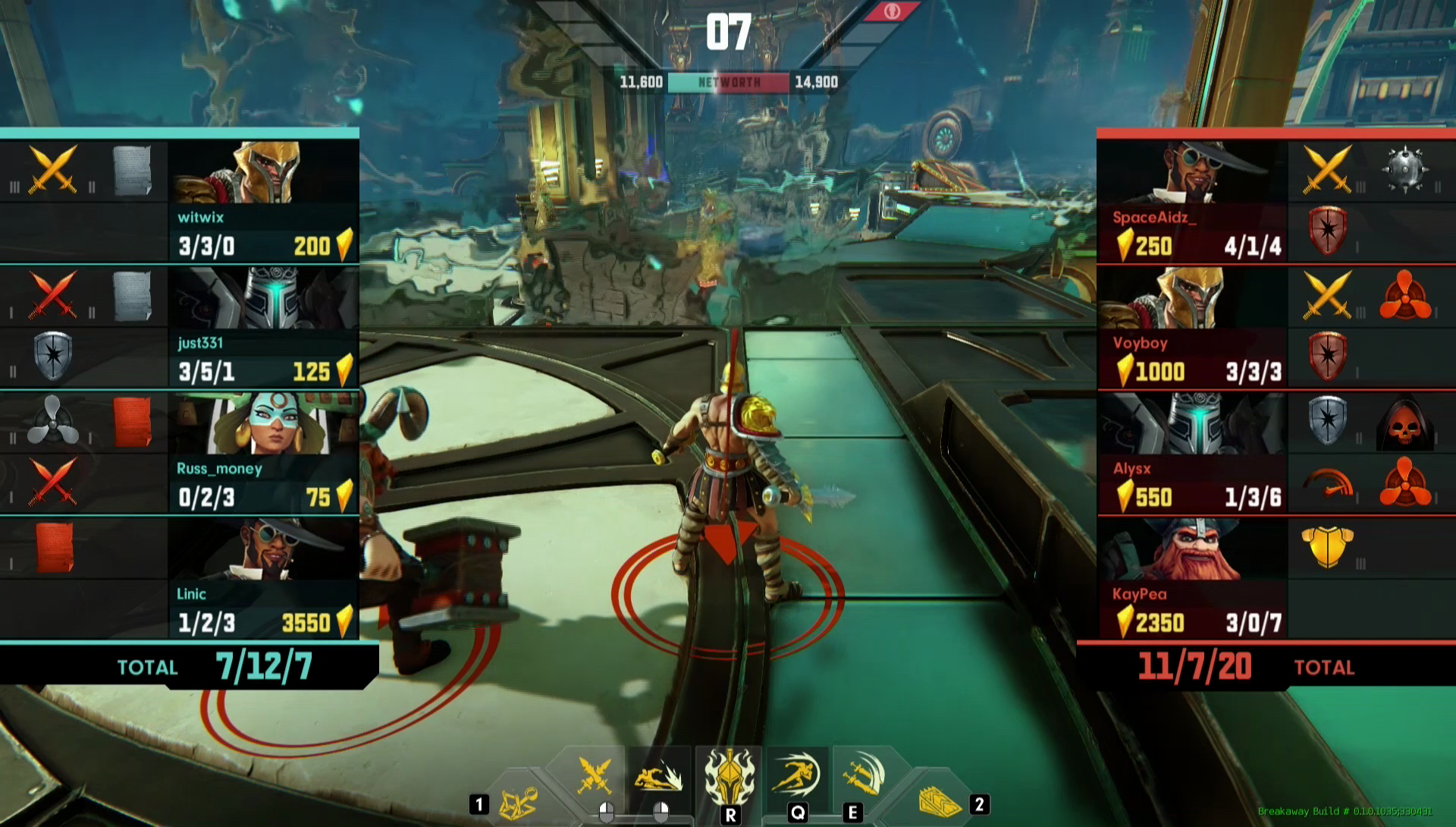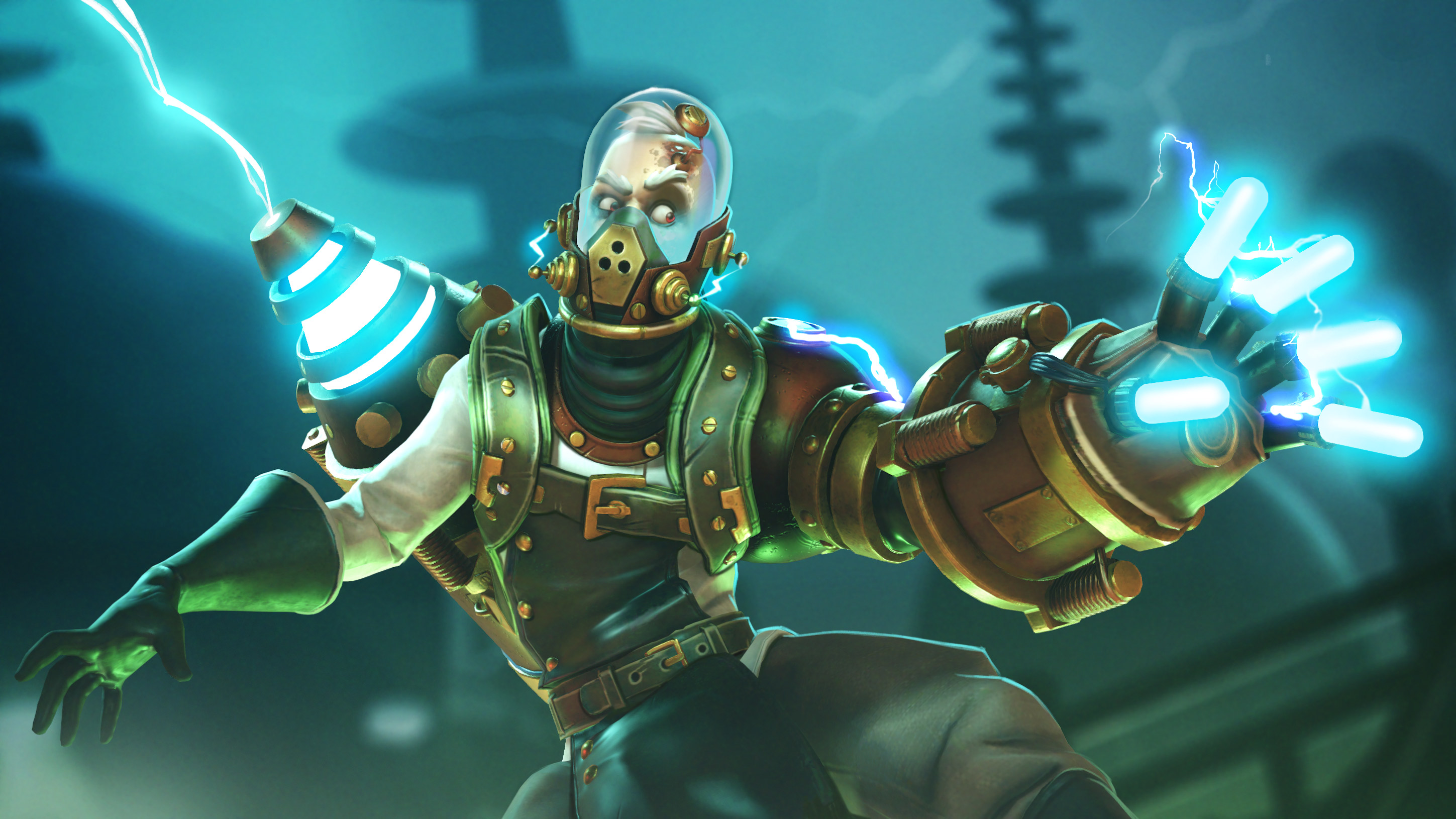Hands-on with Amazon's bizarre no-lane MOBA Breakaway
Breakaway, Amazon's basketball-meets-MOBA is a fun, but messy, mix of ideas.
When Tennyson recounted the legend of King Arthur, I'm guessing he didn't anticipate Arthur's half-sister Morgan le Fay trying to dunk a giant gold ball over the head of notorious pirate Anne Bonny in a 2016 electronic sport. He probably wouldn't quite know what to make of Spartacus, who just kicked a Will-Smith-in-Wild-Wild-West clone off the side of our arena in the fabled city of Atlantis, securing a power play for our team as we push into the enemy base to score. I'm not quite sure what to make of it all, myself—Amazon Game Studios' Breakaway is a strange amalgamation of MOBA and basketball, with an utterly random cast of heroes and a frenetic pace that makes Rocket League feel like a relaxing day at the spa. The answer to the question "how do you make a new MOBA in 2016" is, apparently, make it weird.
Amazon called Breakaway a "4v4 mythological sport brawler," though I've seen it referred to colloquially as a MOBA. That sets the wrong expectations. There are no lanes with minions in Breakaway, no creeps pushing up towards defensive towers. There are no towers. There's no jungle, no in-match leveling to improve your stats and abilities, and there sure as hell isn't a laning phase. This is pure action from the start. The only thing really carried over from MOBAs are the hero abilities: two specials on Q and E, an ultimate on R, and a right-click move that typically serves as a dodge or teleport.
In my first Breakaway round at a preview event for the upcoming Breakaway alpha launch, the enemy team scored on us in the opening 10 seconds, picking up the ball from its position mid-map, running it into our base, and depositing it in the beam of light that represents our goal. I still had the shop menu open, reading item descriptions.

Into the fray
There's not much time for reading in Breakaway, or doing anything else at a measured pace. In the span of a fast four-minute round, you'll buy some gear, throw down two 'buildables,' offensive or defensive structures unique to each hero that can each be built once per round, and spam abilities in chaotic teamfights as hard to read as the most hectic moments of League of Legends or Dota. The difference, in this case, is you also have to keep your eye on the golden ball your teams are scrapping over, trying to carry into the enemy base.
It's chaos, and chaos can be fun. I played more than an hour of exciting and tense matches, and did my best with Morgan le Fay, a spellcaster who primarily helps amp up her team's damage and crowd control the enemy. I would cast a debilitating AOE that slowed the enemy team and let my teammates deal extra damage to anyone inside it, while Anne Bonny sniped from afar and Spartacus got in close for some melee combos.
To someone just picking up the game, though, chaos can also feel unfocused, jumbled action. Cooldowns are short enough that you'll likely be using your Ultimate in just about every engagement. Abilities fire off instantly on keypress without the aiming indicators most MOBAs default to, and with a 3D behind-the-back camera, it's often hard to judge where these attacks will land. With experience, this is obviously something you'll get a feel for, but the range, size, and angle of attack on your abilities is much harder to discern than it is in, say, League of Legends.
I don't think I've played another arena-style combat game that made aiming abilities feel quite this much like guesswork. Even Smite, another behind-the-back action MOBA, has UI indicators to help you judge direction and distance.
The biggest gaming news, reviews and hardware deals
Keep up to date with the most important stories and the best deals, as picked by the PC Gamer team.
Fights almost always take place around the ball, which spawns in the middle of the map and can be picked up by any player who walks over it. The ball attaches to your hero as you touch it, rather than behaving like a physics-driven ball a la Rocket League. When you're hit with a substantial attack the ball lazily pops off your hero and slowly falls to the ground. Fights around the ball turn into a jumble because it doesn't react like a physical object that has any weight in this world, affected by gravity or momentum. It just plops onto the ground. If you're casting an ability and walk over the ball, or use a dodge move to move past it, you can't pick it up. Half a dozen times in my play session I either thought I walked over the ball and didn't, or did walk over the ball but didn't pick it up, or someone else picked up the ball when we both walked near it at the same time.
Practice would absolutely help me read these scenarios better, but it wouldn't make picking up the ball or knocking it from someone's hands more satisfying. It's just missing that oomph of physicality. Possessing the ball changes your moveset, which makes sense but can cause problems in a chaotic fight. Instead of attacking with left-click you throw the ball, right-click is a dodge move with a long cooldown, and E will pass the ball to a nearby teammate. At one point the chaos really bit me: somehow the ball ended up in my hands without me knowing it, and instead of attacking I lazily tossed it on the ground for the enemy to pick up and score with.
There's definitely excitement in running the ball into the enemy base like an inexplicably axe-wielding quarterback, but when you throw the ball it moves with all the enthusiasm of a papier-mâché blob, and it pops out of your body with a casual yawn after a single ability hit. None of it has the punch I'd expect from a real sport, even if the structure of the game—flashy hero abilities mixed with passing the ball and juking enemies to score—is an inherently fun mix.
But hey, if you don't want to score football-style, there are other ways to win! The strange hodgepodge of characters extends to Breakaway's three victory conditions and two other MOBA/tower defense holdovers, an item store and defensive structures. Carrying the ball to the enemy base is the basic way to win a round, but if the timer runs out, the victory's decided by which side of the map the ball is currently on. If it's in your half, you lose. This seems like a concession to keeping matches short and snappy, because some kind of overtime or sudden death would be a much more exciting finish.
The final victory condition is totally different—wipe the whole enemy team of four simultaneously, before any of their 10-ish second respawn timers are up, and you win the round on the spot.
Also, every hero can build two unique offensive/defensive structures on the map that stay between rounds unless they're destroyed. The healer Alona builds a tower that heals nearby allies, for example, while Morgan can build one that responds to the damage of nearby fights by injuring your opponents. The barebones item store, which contains about a dozen total items to buff damage, defense and abilities, feels more like a holdover of what MOBA players expect than a system that needs to be in a mythological sports brawler.
Also also, characters can slide down ramps (including stairs, because to hell with steps I guess) for a quick momentum boost. I appreciate Breakaway's commitment to being a fast competitive game with movement and combat skills to master, but the three victory conditions and the buildings and the shop end up making it feel like the Baseketball of MOBAs—just cram a whole bunch of ideas together instead of focusing closely on one objective. Yeah, you could do all of these things in one game. But should you?

Amazon Game Studios was smart to build something different out of the bones of the MOBA in 2016: Breakaway is at least more interesting than another game about pushing minions up lanes and taking towers and leveling mid-match. Nobody needs another Dota clone. But compared to another MOBA offshoot like Battlerite, which focuses purely on combat and does one thing very well, Breakaway bulges with about four ideas too many. Morgan le Fay, meet the kitchen sink.
I'm being hard on Breakaway, especially considering I had fun for the hour and a half I played it. But when the theme of contemporary competitive games involves learning the unique movesets of a dozen (or a hundred) heroes, it takes something special to break through. Breakaway has a fun concept, but for it to have a competitive future, Amazon needs to use this alpha period to really focus on what it does well (and consider shaving off anything inessential to the idea of a mythological sports brawler).
The first open alpha weekend begins this Thursday and runs through Sunday. You can sign up for the alpha using a Twitch ID through the Breakaway website.

Wes has been covering games and hardware for more than 10 years, first at tech sites like The Wirecutter and Tested before joining the PC Gamer team in 2014. Wes plays a little bit of everything, but he'll always jump at the chance to cover emulation and Japanese games.
When he's not obsessively optimizing and re-optimizing a tangle of conveyor belts in Satisfactory (it's really becoming a problem), he's probably playing a 20-year-old Final Fantasy or some opaque ASCII roguelike. With a focus on writing and editing features, he seeks out personal stories and in-depth histories from the corners of PC gaming and its niche communities. 50% pizza by volume (deep dish, to be specific).

